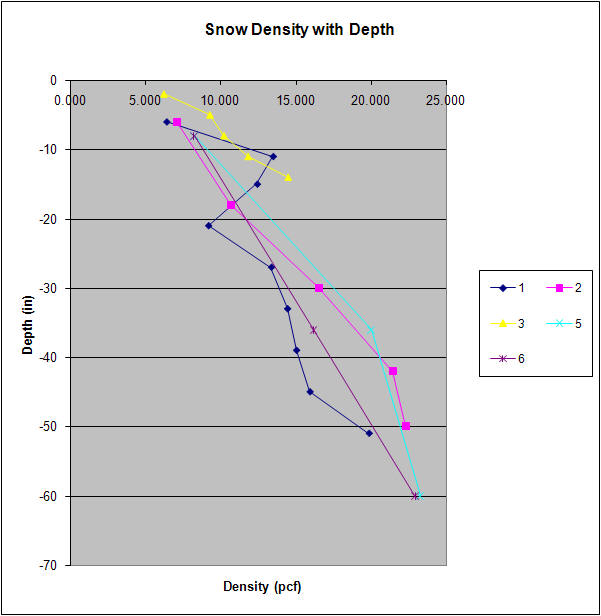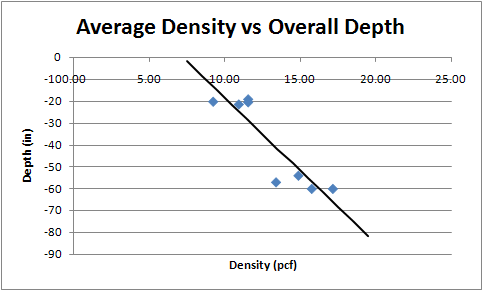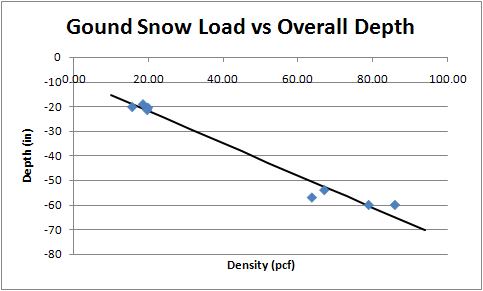| Overview |
| Ground Snow Load |
| Flat Roof Snow Load |
| Sloped Roof Snow Load |
| Partial Loading |
| Unbalanced Snow Load |
| Drifts |
| Sliding Snow |
| Example Problems |
|
References |
| Report Errors or Make Suggestions |
Section 8.2
Ground Snow Load, pg
Last Revised: 11/04/2014
The basis for the snow load computation in ASCE 7-05 is the ground snow load. The value used for the ground snow load should represent the snow load that has a 50 year mean recurrence interval, or, in other words, a 2% probability of being exceeded in any given year. As mentioned in the ASCE 7-05 commentary, the values proposed in the specification are the result of extreme value statistical analysis using weather records.Using the ASCE 7-05 Maps & Tables
ASCE 7-05 Figure 7-1 shows a map of the United States with contours for ground snow load. In the mountainous western US there are large areas listed as being "CS". Site specific case studies are required in these areas. Experience has shown that there are very large local variations in snow load in mountainous regions. Local knowledge should be obtained in these areas, particularly when snow records are few or non-existant.
For the US state of Alaska, Table 7-1 gives ground snow loads for a number of communities. In the case of Alaska, there are few recommendations for most remote areas of the state. Some weather data is available from which statistical analysis can be done for many locations.
Site Specific Case Studies
Site specific case studies are needed when either the ASCE 7-05 map and table don't provide the required data or there is suspicion that the published general values are not accurate for the site. The commentary discusses the factors that should be considered in making a site specific study.
History of development in arctic regions in the past 40 years has shown many cases where improper snow load decisions were made because of the lack of credible data. In regions where data is lacking, it best to be very conservative in your ground snow load estimates. Where possible local records and experience should be included in the snow load decision.
Snow load data obtained depth measurements can be reasonably accurate IF an accurate average snow density can be found. This density may vary with elevation and latitude. Figure 8.2.1 shows some snow density vs. depth measurements taken in the southcentral Alaska during the winter of 2006-2007. Each curve represents the density vs depth measurements for a single test hole. You will note that there is a difference in the density of the snow at the several locations.
Figure 8.2.1
Snow Density vs Depth

All the deep samples were from similar snow. Curve 3 came from a different location where the snow is "heavier", or wetter, when it falls and is more likely to be subjected to warming spells than is the snow from the other regions. Consequently the snow for curve 3 tends to be denser at depth than the other snow. To accurately determine the load created by this snow simply as a function of depth would require different average densities.
It is also interesting to note the non-linear variation in curve 1. This sample had a crust that had formed from both rain and wind consolidation that only affected the upper part of the snow pack.
Note that the average density of the snow increases with depth. This is further illustrated in Figure 8.2.2 which shows average density vs. overall snow depth from a series of measurements taken in the winter of 2006-2007 in southcentral Alaska. These are the types of density that you would multiply against snow depth to obtain a snow load value from measured depth.
Figure 8.2.2
Average
Density vs. Overall Depth

The linear regression on the shown data set yields the equation:
Snow Density = 0.122 * abs(Snow Depth, in.) + 8.32
Where the snow density is in pounds per cubic foot (pcf) and the depth is in inches.
Note that this is not enough data to support using this as a general equation for snow density! It is used here just to illustrate the variation in average density with snow depth. It is very likely that this type of analysis in more temperate climates would yield higher densities than those shown here.
The above data is converted to ground snow load by multiplying the densities by the depths. This computation is done and displayed in Figure 8.2.3. The values shown here are in terms of pg as used in ASCE 7-05.
Figure 8.2.2
Average
Density vs. Overall Depth

The linear regression equations is:
Ground Snow Load = 1.50 * abs(Snow Depth, in.) - 12.40
Note that this is not enough data to support using this as a general equation for ground snow load! It is used here just to illustrate the the computation of snow loads using field data. It is very likely that this type of analysis in more temperate climates would yield higher densities than those shown here.
If you need to base your load estimate off of snow depths, it it best to be conservative.
Figure 8.2.4
Measuring Ground Snow Load